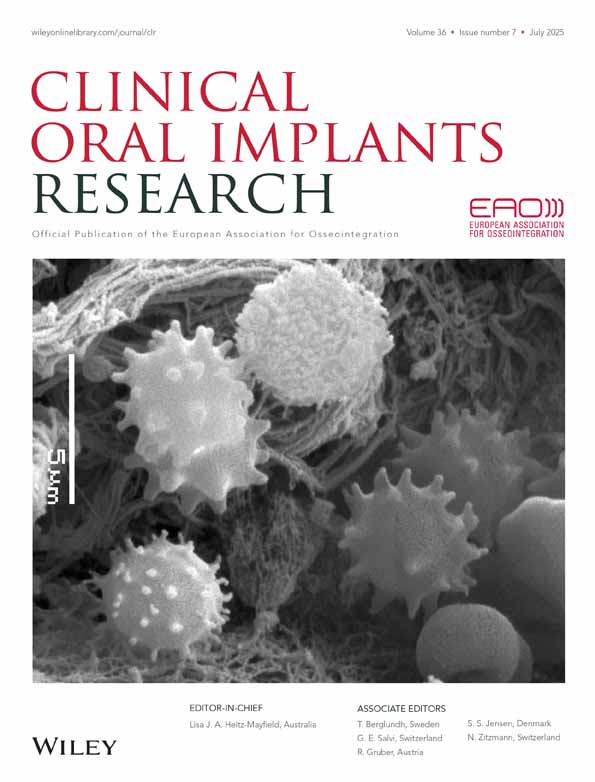Bone level changes proximal to oral implants supporting fixed partial prostheses
Abstract
enAbstract: The success of oral implant treatment relies on the presence and maintenance of bone adjacent to implants. The monitoring of radiographic bone level changes provides valuable insight into the longevity of oral implants. The purpose of this study was to measure radiographic bone level changes proximal (mesial and distal) to Brånemark System® implants (Nobel Biocare AB, Göteborg, Sweden) supporting fixed partial prostheses. Measurements were used to determine mean bone loss for the first year of loading by the prosthesis and the mean annual bone loss for subsequent years. These results were then compared and contrasted with various characteristics of the individuals, treatment, and treatment outcomes. Fifty-five subjects with 69 fixed partial prostheses supported by 160 implants were followed over a 1 to 12-year period. A mean bone loss of 0.33 mm (SD 0.59) was measured for the first year of loading and a mean annual bone loss of 0.00 mm (SD 0.11) after the first year. The radiographic bone loss calculated for implants at the first year of loading was positively correlated with the mean annual bone loss thereafter. Males, younger individuals and those implants supporting distal extension prostheses lost significantly more bone in the first year of loading. Larger numbers of implants followed for longer periods of time are needed to further explore the effects of various aspects of treatment on bone loss.
Résumé
frLe succès du traitement par implants dentaires est basé sur la présence et la maintenance de l'os adjacent aux implants. Le suivi des variations du niveau osseux radiographique apporte une information valable de la longévité des implants dentaires. Le but de cette étude a été de mesurer les variations proximales du niveau osseux radiographique (mésial et distal) d'implants ad modum Brånemark® supportant des prothèses fixées partielles. Des mesures ont été utilisées de mise en charge par des prothèses et la perte osseuse annuelle moyenne pour les années subséquentes. Ces résultats ont ensuite été comparés et contrastés avec différentes caractéristiques des individus, du traitement et des résultats du traitement. Cinquante-cinq sujets avec 69 un à douze ans. Une perte osseuse moyenne de 0,33 ± 0,11 mm après la première année de charge était en corrélation positive avec la perte osseuse moyenne annuelle s'effectuant par la suite. Les hommes, les individus jeunes, et les implants supportant les prothèses avec extension distale perdaient davantage d'os durant la première année de mise en charge. Un grand nombre d'implants suivis durant de longues périodes s'avère nécessaire pour explorer davantage les effets des différents aspects du traitement sur cette perte osseuse.
Zusammenfassung
deDer erfolg von oralen ?mplantaten beruth auf dem Vorhandensein und dem Erhalt von Knochen um die ?mplantate. Die Aufzeichnung der Veränderungen der radiologischen Knochenniveaus liefert wertvolle ?nformationen über den Langzeiterfolg von ?mplantaten. Das Ziel der Studie war es, die Veränderungen der radiologischen Knochenniveaus approximal (mesial und distal) von ?mplantaten des Brånemark Systems® (Bio Nobelcare AB, Göteborg, Schweden), auf welchen festsitzende Rekonstruktionen verankert sind, zu messen. Die Messungen wurden verwendet, um den mittleren Knochenverlust im ersten Jahr der Belastung durch die Rekonstruktionen und den mittleren Jährlichen Knochenverlust in den folgenden Jahren zu bestimmen. Diese Resultate wurden dann verglichen und verschiedenen Charakteristiken der ?ndividuen, der Behandlung und des Behan dlungsresultats gegenübergestellt. Fünfundfünfzig Subjekte mit 69 festsitzenden Rekonstruktionen, welche auf 160 ?mplantaten verankert waren, wurden über einen Zeitraum von 1 bis 12 Jahren beobachtet. ?m ersten Jahr der Belastung wurde ein mittlerer Knochen verlust von 0.33 mm (SD 0.59) gemessen. Nach dem ersten Jahr wurde ein jährlicher Knochenverlust von 0.00 mm (SD 0.11) registriert. Der radiologische Knochenverlust der ?mplantate, welcher für das erste Jahr der Belastrung berechnet wurde, war mit dem Kn ochenverlust der folgenden Jahre positiv korreliert. Männer, junge ?ndividuen und die ?mplantate, welche Rekonstruktionen mit distalen Extensionen trugen, verloren im ersten Jahr der Belastung signifikant mehr Knochen. Eine grössere Anzahl ?mplantate, welche über einen längeren Zeitraum beobachtet werden muss, ist nötig, um weitere Einflüsse der verschiedenen Aspekte der Behandlung auf den Knochenverlust untersuchen zu können.
Resumen
esEl exito del tratamiento con implantes orales recae en la presencia y mantenimiento de hueso adyacente a los implantes. La monitorización de los cambios radiográficos en el nivel de hueso suministra una visión valiosa sobre la longevidad de los implantes orales. El propósito de este estudio fue medir los cambios radiográficos en el nivel de hueso proximal (mesial y distal) de implantes del sistema Brånemark® (Nobel Biocare AB, Goteborg, Sweden) soportando prótesis parciales fijas. Se usaron mediciones para determinar la perdida media de hueso durante el primer año de carga por la prótesis y la perdida media anual de hueso en los años siguientes. Estos resultados se compararon y contrastaron con varias características de los individuos, tratamiento y resultados del tratamiento. Se siguieron cincuenta y cinco sujetos con 69 prótesis parciales fijas soportadas por 160 implantes durante un periodo de 1 a 12 años. Se midieron unas perdidas de hueso medias de 0.33 mm (SD 0.59) tras el primer año. La pardida de hueso radiográfico calculada para implamtes en el primer año de carga fue positivamente correlacionada con la perdida media anual de hueso posterior. Los varones, individuos mas jóvenes, y aquellos implantes soportando prótesis con extensiones distales perdieron significativamente mas hueso en el primer año de carga. Se necesita un mayor numero de implantes sequidos durante periodos de tiempo mas largos para exploras mas allá los efectos de varios aspectos del tratamiento de la perdida ósea.




